How to give a presentation
Does the thought of public speaking start your stomach churning like a tornado? Would you rather get caught in an avalanche than give a speech? Giving an oral report does not have to be a natural disaster. There are two main elements—the writing and the presentation. Find out how to put it all together with tips from the Nat Geo Kids Almanac .

Writing Your Material
Try to keep your sentences short and simple. Long, complex sentences are harder to follow. Limit yourself to just a few key points. You don’t want to overwhelm your audience with too much information. To be most effective, hit your key points in the introduction, elaborate on them in the body, and then repeat them once again in your conclusion.
The three basic parts
• Introduction—This is your chance to engage your audience and really capture their interest in the subject you are presenting. Use a funny personal experience or a dramatic story, or start with an intriguing question.
• Body—This is the longest part of your report. Here you elaborate on the facts and ideas you want to convey. Give information that supports your main idea, and expand on it with specific examples or details. In other words, structure your oral report in the same way you would a written essay so that your thoughts are presented in a clear and organized manner.
• Conclusion—This is the time to summarize the information and emphasize your most important points to the audience one last time.
Preparing Your Delivery
Practice makes perfect. Confidence, enthusiasm, and energy are key to delivering an effective oral report, and they can best be achieved through rehearsal. Ask family and friends to be your practice audience and give you feedback when you’re done. Were they able to follow your ideas? Did you seem knowledgeable and confident? Did you speak too slowly or too fast, too softly or too loudly? The more times you practice giving your report, the more you’ll master the material. Then you won’t have to rely so heavily on your notes or papers, and you will be able to give your report in a relaxed and confident manner.
Present with everything you’ve got
Be as creative as you can. Incorporate videos, sound clips, slide presentations, charts, diagrams, and photos. Visual aids help stimulate your audience’s senses and keep them intrigued and engaged. They can also help to reinforce your key points. And remember that when you’re giving an oral report, you’re a performer. Take charge of the spotlight and be as animated and entertaining as you can. Have fun with it.
Keep your nerves under control
Everyone gets a little nervous when speaking in front of a group. That’s normal. But the more preparation you’ve done—meaning plenty of researching, organizing, and rehearsing—the more confident you’ll be. Preparation is the key. And if you make a mistake or stumble over your words, just regroup and keep going. Nobody’s perfect, and nobody expects you to be.
Download the pdf.
Homework help
Science lab, (ad) national geographic kids almanac.
- Terms of Use
- Privacy Policy
- Your California Privacy Rights
- Children's Online Privacy Policy
- Interest-Based Ads
- About Nielsen Measurement
- Do Not Sell My Info
- National Geographic
- National Geographic Education
- Shop Nat Geo
- Customer Service
- Manage Your Subscription
Copyright © 1996-2015 National Geographic Society Copyright © 2015-2024 National Geographic Partners, LLC. All rights reserved
Speech Blubs
by Blub Blub
Browse topics
All blog posts 404
Popular topics
100+ fun activities for kids that will keep them entertained for hours! Target speech development through play and games. They won’t even know they are learning!
Learn about your baby and toddler developmental milestones! Check if you are on track, when to worry, and how to work on skills like language, potty training, and feeding!
Every child is different! Here are speech and language tips and tools for kids with learning differences, alongside information for parents provided by speech therapists.
Parenting starts with your well-being! Here is some advice on how to teach life skills, work from home, distance learning, along with tips for developing parenting coping skills.
We help kids speak no matter their speech challenges! Speech therapists advise parents about late talkers, speech delay, stuttering, apraxia, articulation, and other speech impediments.
From your first worry to your first appointment, and your last speech therapy session – find the information you need to help your child thrive and gain necessary speech skills.
Parent's Academy › Activities for Kids › Preschool Activities › Public Speaking for Kids: 30 Topic Ideas for 30 Days
Public Speaking for Kids: 30 Topic Ideas for 30 Days
Samidha raj.
Writer , Jersey City , New Jersey
A great public speaker, whether a young child or a seasoned professional, is someone who reflects charisma and confidence to captivate their audience. It’s okay to feel nervous or to have fear of public speaking. Great public speakers often get nervous, but this nervous energy keeps their adrenaline flowing.
However, what is not okay is sounding and looking nervous when speaking in public. This makes the audience feel disconnected from the speaker. Public speaking training for kids seems like a daunting task, but it’s really a matter of practice.
Help your children to project magnetism and self-assuredness when they speak with these 30 inspiring speech topics for 30 days. Your kids can practice public speaking by taking one topic every day for the next 30 days. This will help them fire their imaginations to be confident public speakers. Here are some topic ideas for public speaking for children, but feel free to invent your own! Choose a topic today!
Boost Your Child’s Speech Development!
Improve language & communication skills with fun learning!

Public Speaking for Kids: Ideas for Topics
Here are the 30 topic ideas for 30 days of the month:
- The best part about living on Earth
- Let me tell you about my imaginary friend
- If you were to write a book for your kids your age to read, what it would be about?
- My favorite cartoon character
- My favorite time of the day or week
- The most delicious meal I’ve ever had
- If I could talk to animals
- If I could change one thing about the world, it would be
- My favorite game
- If I had a million dollars, what would I do?
- My dream job
- The funniest movie I have ever seen
- My typical day at school
- What sports do you like? Why?
- Interesting things you see in the sky
- The best day of my life
- My best friend
- A much-needed invention
- What planet would you visit and why?
- If you could have one superpower, what it would be?
- What’s your favorite outdoor activity?
- Tell us why too much TV is bad for your health
- If you could make one toy, what would it be?
- What is your favorite thing to do with your family?
- If you were the President for the day, what would you do?
- If you could be any animal, what animal would you be?
- What is your favorite subject in school, and why?
- What is your least favorite food?
- What’s the first thing you think of when you wake up?
- What is your favorite kind of music, and why?
Speaking on the above topic ideas will instill the power of confidence in your kids. When your child is charged with a healthy dose of self-assurance, nothing can get in the way of their success. So, take this 30-day, 30-topic challenge and boost your child’s confidence in becoming a great public speaker. You will see a decided improvement in your child’s eye contact, body language, and presentation skills.
Free Assessment!
Take this quiz and get a report on your child’s milestones and a personalized learning plan.

Have a question for our Speech Therapists?
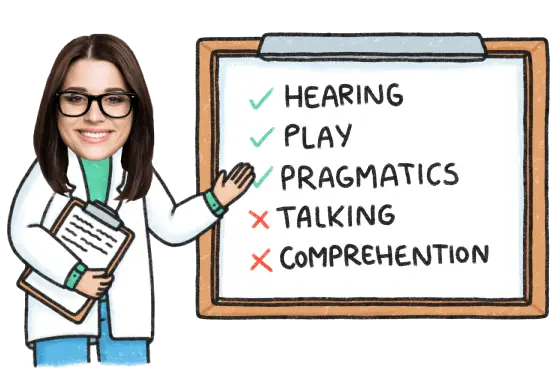
The author’s views are entirely his or her own and may not necessarily reflect the views of Blub Blub Inc. All content provided on this website is for informational purposes only and is not intended to be a substitute for independent professional medical judgement, advice, diagnosis, or treatment. Always seek the advice of your physician or other qualified health provider with any questions you may have regarding a medical condition. Never disregard professional medical advice or delay in seeking it because of something you have read on this website.
Related articles
Kids games that teach hygiene.
I have a toddler (3-years-old) and we started around the age of 2 to show her the basics of hygiene: the good handwashing habits and…
Developing Language Understanding at Home
Now, your little ones might not be at school or nursery, or your local speech therapy might not be available, but this doesn’t mean your…
Get started with Speech Blubs
Cancel anytime, hassle-free!

Making English Fun
18 Presentation Tips for Kids
Preparing for a presentation can feel like a big task, but it’s also an awesome opportunity to share knowledge and express creativity.
This guide is designed to help students step up their presentation game and feel more confident in front of the class.
We’ve put together a bunch of handy tips covering everything from choosing a topic to wrapping up the presentation with style.
- Teachers, these tips will be great tools to guide your students in crafting engaging and effective presentations.
- Students, these are your steps to becoming presentation pros!

Whether it’s managing nerves, keeping your audience engaged, or making your points clearly, these tips are here to help you shine.
Let’s get started and turn those presentation jitters into a round of applause!
We have a table of these tips at the end of the article to download you can give to your class, or use yourself .
Section 1: Before the Presentation
Before you even step in front of your audience, there’s plenty to do. From picking a topic you love to practicing your speech, these tips will help you get ready and set the stage for a fantastic presentation.
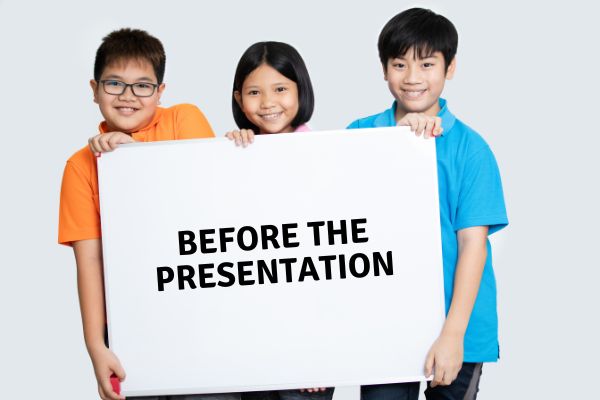
1. Choosing an Engaging Topic:
Picking a topic can be fun! It’s great when kids talk about something they love, like a hobby or a cool project they did. When kids are into their topic, their presentation naturally becomes more lively and interesting.
Presentation Tip: A good tip is to have a chat with them about what they enjoy or what they’ve been curious about lately. This way, they can find a topic that they’re really excited to share with others.
We actually have sets of presentation scripts ready to use to practice if you wish to get some ideas.
2. Research and Organizing Content:
Finding out cool stuff about their topic is like a treasure hunt for kids. Encourage them to look up information in books or online, but make sure they use websites that are just right for their age.
Presentation Tip: A fun tip is to use colorful sticky notes or draw a mind map to sort their ideas.
This makes it easier to see what they want to talk about first, next, and last. It’s like putting together pieces of a puzzle to tell a great story.
3. Designing Effective Visual Aids:
Making posters or slides can be a blast. Remind kids to keep things simple – big words they can read and neat pictures that show what they’re talking about.
Presentation Tip: A good trick is not to cram too much onto one page or slide.
Just a few key points and images are enough to make their presentation pop and help everyone understand better.
4. Rehearsing the Presentation:
Practice makes perfect! Instead of practicing all at once, breaking it up into shorter sessions can make it more doable and fun.
Presentation Tip: They can try speaking in front of a mirror, recording themselves, or even presenting to their stuffed animals or family.
This helps them get better at talking about their topic and feel more ready for the big day.
5. Managing Nervousness:
It’s totally normal to feel a bit jittery before presenting. Teach them to take deep breaths or think of something happy to calm those butterflies in their stomach.
Presentation Tip: Remind them that it’s cool to be a bit nervous, and everyone feels that way sometimes.
The more they practice in a friendly setting, the more they’ll feel like they can rock their presentation.
Section 2: During the Presentation
Now, it’s showtime! This is where all your preparation pays off. These tips will guide you on how to engage your audience, deliver your message clearly, and handle any surprises with confidence. Let’s make your presentation shine!
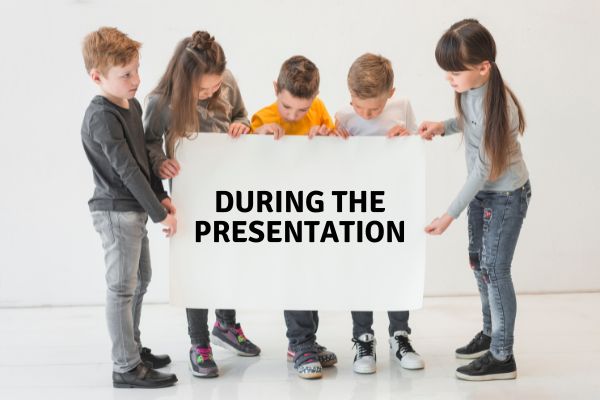
6. Confident Opening:
Beginning the presentation with confidence sets the tone. Encourage kids to start with something they’re genuinely excited about, like an interesting fact or a personal story related to their topic. This immediately captures the audience’s attention.
Presentation Tip: Practicing the opening lines several times can help them memorize and deliver them confidently.
Remind them that a strong and engaging start not only grabs attention but also boosts their confidence for the rest of the presentation.
7. Clear and Measured Speech:
Speaking clearly and at a comfortable pace is essential. A useful technique is to imagine speaking to someone at the back of the room, ensuring they speak loudly and enunciate each word.
Presentation Tip: Encourage them to take brief pauses, especially after key points, to let the audience absorb the information.
This also gives them a moment to gather their thoughts before moving on.
8. Engaging Eye Contact:
Eye contact is a powerful way to connect with the audience.
Presentation Tip: Teach kids to look around the room, making brief eye contact with different people.
It’s like having mini conversations within their presentation, which makes it more engaging and personal.
This technique can also help in reducing nerves as they focus on individual faces rather than the entire audience.
9. Effective Use of Visual Aids:
Visual aids are there to support, not dominate, the presentation. Kids should use them to highlight key points or explain complex ideas.
Presentation Tip: Teach them to glance at the aid for reference, then direct their attention back to the audience while explaining.
This ensures the audience focuses on their explanation rather than getting distracted by the visual aid.
10. Engage with the Audience
Audience engagement turns a presentation from a monologue into an interactive experience. Encourage students to connect with their audience by asking rhetorical questions, incorporating short activities, or simply by showing enthusiasm for their topic.
Involving the audience makes the presentation more dynamic and interesting.
Presentation Tip: Kids can ask a question, conduct a quick poll, or invite responses to a statement.
This not only keeps the audience engaged but also makes the presentation more interactive and enjoyable for the presenter.
11. Stay Calm and Composed
Keeping calm under the spotlight is key. Teach students techniques to manage presentation nerves, such as deep breathing or positive visualization. Remind them that it’s okay to pause for a moment to collect their thoughts during the presentation.
Presentation Tip: A good way to practice staying composed is through ‘distraction drills,’ where students present while facing minor, planned interruptions.
This helps them learn to maintain focus and composure, regardless of unexpected circumstances
12. Stand Straight
A good posture and standing straight are essential for a confident presentation. Encourage students to stand straight, as it not only improves voice projection but also displays confidence, if you display it you might just feel it as well.
Presentation Tip: An effective way to practice this is to set up an exercise where students speak to a ‘back row,’ ensuring they’re audible without shouting.
13. Projecting Voice:
Being heard clearly is essential. no mouse voices need here! While you don’t have to shout, though that might be funny!, you do have to get the message to the room, that might be a classroom or a school hall!
Presentation Tip: Encourage practicing in larger spaces to get comfortable with projecting their voice.
This helps ensure that their message is delivered clearly to everyone in the room, even those at the back.
14. Impactful Conclusion:
Ending on a strong note is crucial. Teach students to wrap up their presentations by summarizing the key points and reiterating the main message. Ending with impact leaves a lasting impression.
Presentation Tip: Encourage them to summarize key points or end with a thought-provoking question or statement.
Remind them that practicing their closing remarks can help in delivering a strong and memorable conclusion.
Section 3: After the Presentation
Great job, you’ve made it through! But there’s still a bit to learn. Reflecting on your presentation, gathering feedback, and recognizing your effort are key steps to improving and celebrating your hard work. Let’s wrap up and look ahead!
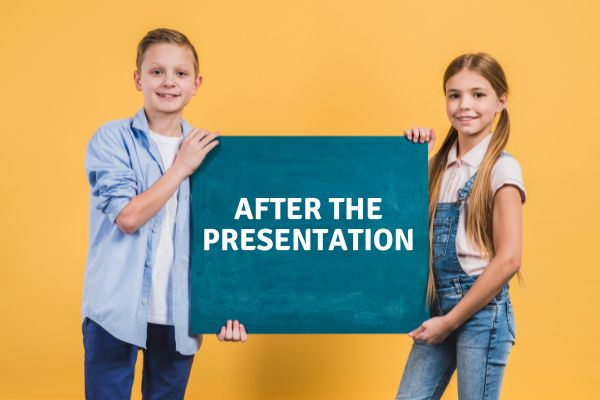
15. Gathering Feedback:
Feedback is a valuable tool for improvement.
Presentation Tip: Encourage kids to ask for specific feedback from peers, teachers, or family members.
Questions like, “What part did you like best?” or “What could I do better next time?” can provide insightful responses. Assure them that receiving feedback is a positive experience and a chance to learn.
16. Personal Reflection:
Reflecting on their own performance is as important as receiving external feedback.
Presentation Tip: Encourage them to think about what parts of the presentation they felt good about and what parts were challenging.
This self-awareness helps them recognize their strengths and identify areas for improvement.
17. Incorporating Feedback:
Using the feedback received effectively is key to growth.
Presentation Tip: Help them understand how to apply constructive criticism to future presentations. This might involve working on speaking louder, making more eye contact, or improving their visual aids.
This process turns feedback into actionable steps for improvement.
18. Acknowledging Effort:
Recognizing the effort and bravery involved in presenting is crucial.
Presentation Tip: Celebrate their hard work and courage, regardless of the presentation’s perfection.
This acknowledgment fosters a positive attitude and encourages them to take on new challenges in the future.
Table of Presentation skills and Tips for Students
This table can be a handy reference for students to understand the key aspects of a good presentation. We have a printable version on the link below and if you want the editable on you can email us on [email protected]
Teachers and students, armed with these tips, you’re now ready to tackle any presentation challenge that comes your way.
- Students, remember that every presentation is a chance to grow and showcase your unique ideas. Don’t be afraid to experiment with different styles and approaches – find what works best for you.
- Teachers, continue encouraging your students to use these strategies, offering support and guidance as they develop their skills.
Each presentation is a stepping stone towards becoming more confident and effective communicators. So, the next time you’re up for a presentation, take a deep breath, embrace these tips, and step confidently onto the stage. You’ve got this!
Further Reading
- Speaking games for Kids
- More presentation Skills
- Teaching presentation skills to kids.
- Public speaking for kids
Share this:
- Click to share on Twitter (Opens in new window)
- Click to share on Facebook (Opens in new window)
- Click to share on Pinterest (Opens in new window)
- Click to share on WhatsApp (Opens in new window)
- Click to email a link to a friend (Opens in new window)
Making English Fun!
I have been a teacher of English for over 15 years, in that time i made hundreds and thousands of resources and learnt so much i think its worth sharing. Hopefully to help teachers and parents around the world.
Similar Posts

How To Make Your Own Educational App
I have had a few requests and inquires over the last few weeks about making or how to make apps for education. All of which i have answered as best i can. My journey into this came from a constant search for games to play in my classroom, which is why i have also lists of the ones i use on the site as well. I really struggled to find ones that I thought were suitable for my learners.

ESL Icebreaker Game “The Story Continues”
“The Story Continues” is an inventive and interactive classroom activity tailored for language learning, particularly beneficial in second language acquisition contexts. This game stands out due to its simplicity and the creative autonomy it offers to students. It’s a multifaceted exercise that not only enlivens the classroom but also greatly enhances language competencies. In this…
FREE Sight Word Worksheets – ‘all’
The sight word “all” is pivotal for young readers, enriching their vocabulary with a term that denotes entirety or completeness. This article is designed for teachers, ESL instructors, and parents committed to supporting early literacy. We provide a free, printable sight word worksheet aimed at helping children master the sight word “all,” promoting a nuanced…

Webb’s Depth of Knowledge (DOK) in Education
Webb’s Depth of Knowledge (DOK) is a framework that has become integral in the field of education for assessing and developing the complexity of students’ cognitive processes. Developed by Norman L. Webb, DOK categorizes tasks based on the complexity of thinking required rather than just the difficulty. This approach offers a nuanced perspective on students’…
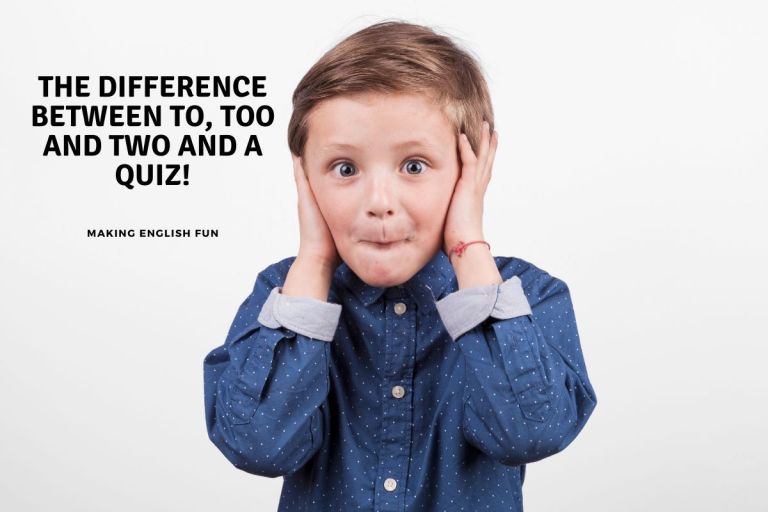
The Difference Between To, Too and Two Quiz
English, with its rich vocabulary and varied expressions, often presents learners with words that sound identical but have different meanings and uses. Three such words are “to,” “two,” and “too.” While they sound similar, each of these words serves a unique purpose in the English language. Word Part of Speech Definition Example to Preposition/Part of…

100+ Chat Gpt Prompts for English Teachers
There has been a lot in the media about how ChatGPT will affect Education and the vast majority of those are tales of woe and calamity. However, we take a difference view and think just like other technologies that have come before it and most certainly will come after it, ChatGPT is just another tool…
Always welcome thoughts and comments, new blogs can be lonely!! Cancel reply
Check out our Premium Products in the shop today Dismiss
Discover more from Making English Fun
Subscribe now to keep reading and get access to the full archive.
Continue reading
You must be logged in to post a comment.


Search Videos
Suggest videos.

Today's Spotlight
More learning activities.


- PRESENTATION SKILLS
Search SkillsYouNeed:
Presentation Skills:
- A - Z List of Presentation Skills
- Top Tips for Effective Presentations
- General Presentation Skills
- What is a Presentation?
- Preparing for a Presentation
- Organising the Material
- Writing Your Presentation
- Deciding the Presentation Method
- Managing your Presentation Notes
- Working with Visual Aids
- Presenting Data
- Managing the Event
- Coping with Presentation Nerves
- Dealing with Questions
- How to Build Presentations Like a Consultant
- Self-Presentation in Presentations
- Specific Presentation Events
- Remote Meetings and Presentations
- Giving a Speech
- Presentations in Interviews
- Presenting to Large Groups and Conferences
- Giving Lectures and Seminars
- Managing a Press Conference
- Attending Public Consultation Meetings
- Managing a Public Consultation Meeting
- Crisis Communications
- Elsewhere on Skills You Need:
- Communication Skills
- Facilitation Skills
- Teams, Groups and Meetings
- Effective Speaking
- Question Types
Subscribe to our FREE newsletter and start improving your life in just 5 minutes a day.
You'll get our 5 free 'One Minute Life Skills' and our weekly newsletter.
We'll never share your email address and you can unsubscribe at any time.
Presentation Skills
Presenting information clearly and effectively is a key skill in getting your message across. Today, presentation skills are required in almost every field, and most of us are required to give presentations on occasions. While some people take this in their stride, others find it much more challenging.
It is, however, possible to improve your presentation skills with a bit of work. This section of SkillsYouNeed is designed to help.
Many people feel terrified when asked to talk in public, especially to bigger groups. However, these fears can be reduced by good preparation, which will also lay the groundwork for making an effective presentation.
There are Different Types of Presentations, but They’re All Presentations
There are any number of occasions when you may be asked to speak in public or to a group of people. They include:
- Presenting or making a speech at a conference or event.
- Objecting to a planning proposal at a council meeting.
- Making a speech at a wedding.
- Proposing a vote of thanks to someone at a club or society.
- On behalf of a team, saying goodbye and presenting a gift to a colleague who is leaving.
- Seeking investment or a loan to help you set up a new business.
These can all be considered presentations.
They do not, however, all require the same approach. You would not, for example, use PowerPoint to thank a colleague who was leaving. It would be unusual (though it has been done) to use it in a speech at a wedding. However, a conference audience would be somewhat surprised NOT to see slides projected onto a screen.
It follows, therefore, that there is no single set of rules that apply to all presentations. There are, however, some things that every presentation opportunity has in common. These include:
You will present better if you have prepared effectively . This does NOT necessarily mean that you have written out your speech verbatim and rehearsed it until you know it off by heart—although that might work for some people. It does, however, mean that you have to be confident that you are saying the right thing, in the right way, to the right people.
You need to be clear about your audience and your message . Every presentation will be better if you have clearly considered the message that you want or need to convey, and how best to convey it to your audience. These two pieces of information drive your style, structure, content, and use of visual aids.
You must never overrun your allocated time . In other words, don’t outstay your welcome. Almost every speech or presentation is better if it is shorter. Nobody minds going for coffee early or finishing before they expected to do so. Everybody minds being held up.
Generally speaking, your audience starts on your side. As a rule, your audience is there (more or less) voluntarily. They have chosen to listen to you, and they want to enjoy your presentation. The occasion is yours to lose.
An Important Point
There is one very important point to remember: if what you’re doing or saying is not working, do something else.
One of the worst feelings as a presenter is that you have lost your audience. You know that’s happened, but you continue to stumble through your remaining PowerPoint slides for the next 15 minutes, as your audience checks their phones and wishes it was coffee time. You think you have no choice, but that’s not actually true.
When you present, you are in charge of the room . The audience has effectively handed you control and is sitting back waiting for you to do something. You may have prepared a specific talk, but if you see that isn’t working, you can always change it. You are, after all, the expert.
You can, for example:
- Skip through some slides to a section that they may find more interesting;
- Ask your audience whether there is particular information that they were expecting that you are not providing;
- Suggest that everyone looks a bit sleepy, and maybe it would be better to start questions early, or have a discussion; or
- Ask the audience at the start of the presentation what they are expecting and what they want you to cover. That way, you can tailor the presentation to fit their expectations.
Just as when you are facilitating, you want to help your audience get the most out of your presentation. The best way to do that is to accept feedback—which may include smiles, nods of interest, or people getting their phones out.
Quick Guide to Effective Presentations
If you need to improve your presentation skills quickly, then a really good place to start is with our Top Tips for Effective Presentations .
This will give you some ‘quick wins’ that will help you improve your presentations. If you’re already an experienced presenter, this page should be a useful refresher, or even take your skills from good to great.
Our tips include general ideas about connecting with your audience, information about the importance of voice and body language, and detailed tips about preparing slide-shows.
The most important tip of all, however, is to remember that it's all about your audience.
Keep that in mind, and your presentation skills will almost instantly improve.
If you have more time to develop your presentation skills…
…then the Presentation Skills section of SkillsYouNeed is designed to help.
Our Presentation Skills section is split into two parts.
- The first gives you a step-by-step guide to putting together and delivering a professional and effective presentation .
- The second provides more detailed information about presenting and communicating in particular circumstances .
You can either use our step-by-step guide to walk you through the presentation preparation and delivery process, or you can focus on particular areas that are an issue for you.
Preparing for Your Presentation
The guide starts by explaining What is a Presentation?
We define a presentation as a means of communication that can be adapted to various speaking situations, such as talking to a group, addressing a meeting or briefing a team. Effective presentations usually require careful thought and preparation—although this preparation need not take very long.
Preparation is the most important part of making a successful presentation. Our page on Preparing For A Presentation explains what information you need before you can really start to plan your presentation and decide what you are going to say. The most important aspects include the objective of the presentation, the subject, and the audience.
Irrespective of whether the occasion is formal or informal, you should always aim to give a clear, well-structured delivery. To do so, you need to organise your presentation material . You can either do this in your head, or use a technique like mind-mapping to help you identify links and good flow.
By the time you come to write your presentation , you should know exactly what you want to say and the order in which you want to say it. You may want to use one of the standard presentation structures, such as ‘What, Why, How?’. You will also find it helpful to consider how to tell your story most effectively, and to use stories in your presentation to illustrate points. There is more about this in our page on writing your presentation .
You also need to decide on your presentation method . Presentations range from the formal to the informal. Your choice of presentation method will depend on many factors, including the audience, the venue, the facilities, and your own preferences.
Visual aids can add another dimension to your presentation, helping to hold your audience’s attention, and also act as a reminder of what you wanted to say. However, they need handling with care. Only use visual aids if they are necessary to maintain interest and assist comprehension . If visual aids are not used well, they can ruin a presentation.
See Working with Visual Aids to avoid falling into the trap of the dreaded ‘ Death by PowerPoint’ .
A particular case of visual aids is the use of data in a presentation.
There are times when using data in a presentation can really help you to tell the story better. It is, however, important not to blind your audience with statistics. You also need to remember that many people find numbers difficult to understand. Our page on Presenting Data gives some hints and tips about using data effectively in a presentation situation.
On the Day of the Presentation
There are a number of aspects to delivering your presentation on the day.
The practicalities of how you manage your presentation can make a significant difference to its success, and to your nerves! For example, turning up early means that you have will have a chance to see the room, and ensure that you can operate all the necessary equipment. There is more about how to cope, including managing sound systems, audio-visual equipment and lecterns in our page on Managing the Presentation Event .
Many people also feel very nervous before and during a presentation. This is entirely normal, and can even be helpful if you can channel it in the right way. There are some tried and tested strategies and techniques to manage your nerves so that you can concentrate on delivering an effective and engaging presentation.
See Coping with Presentation Nerves for some ideas that will help.
How you present yourself can also affect how your audience responds to your presentation.
You need to fit with your audience's expectations if they are not going to spend quite a large chunk of your presentation dealing with the differences between expectations and reality.
For more about aspects of self-presentation, see our page on Self-Presentation in Presentations .
You also need to consider how to manage your presentation notes .
Few people are able to give a presentation without notes. You will need to know your own abilities and decide how best to make the presentation. You might manage your talk by using full text, notes on cue cards, keywords on cue cards, or mind maps. There is more about this in our page on Managing your Presentation Notes .
After the presentation, you may be faced with a question-and-answer session. For many people, this is the worst part of the event.
Decide in advance how and when you wish to handle questions. Some speakers prefer questions to be raised as they arise during the presentation whilst others prefer to deal with questions at the end. At the start of your presentation, you should make clear your preferences to the audience. See our page on Dealing with Questions for more ideas about how to make the question session pleasant and productive, rather than something to dread.
Presenting Under Particular Circumstances
You may find that you need to give a presentation under certain circumstances, where your previous experience is less helpful.
Circumstances that may be new to you include:
- Giving a Speech , for example, at a wedding.
One particular special case is attending public consultation meetings.
Our pages on Attending Public Consultation Meetings , and Managing Public Consultation Meetings provide information to help whether you are a concerned member of the public, or responsible for organising a public meeting.
You may also find yourself required to organise or manage a press conference.
Although this may not strictly be what you would describe as a ‘presentation’, it is nonetheless an event at which you are required to present your organisation in a particular light.
Our page on Managing a Press Conference gives some ideas about how best to do that.
Finally, should you be unlucky enough to be involved in a serious crisis or disaster that affects your organisation, our page on Crisis Communications gives some ideas about how to manage press and public relations on these occasions.
Start with: What is a Presentation? Top Tips for Effective Presentations
See also: Personal Appearance Interpersonal Communication Skills

How it works
Transform your enterprise with the scalable mindsets, skills, & behavior change that drive performance.
Explore how BetterUp connects to your core business systems.
We pair AI with the latest in human-centered coaching to drive powerful, lasting learning and behavior change.
Build leaders that accelerate team performance and engagement.
Unlock performance potential at scale with AI-powered curated growth journeys.
Build resilience, well-being and agility to drive performance across your entire enterprise.
Transform your business, starting with your sales leaders.
Unlock business impact from the top with executive coaching.
Foster a culture of inclusion and belonging.
Accelerate the performance and potential of your agencies and employees.
See how innovative organizations use BetterUp to build a thriving workforce.
Discover how BetterUp measurably impacts key business outcomes for organizations like yours.
A demo is the first step to transforming your business. Meet with us to develop a plan for attaining your goals.

- What is coaching?
Learn how 1:1 coaching works, who its for, and if it's right for you.
Accelerate your personal and professional growth with the expert guidance of a BetterUp Coach.
Types of Coaching
Navigate career transitions, accelerate your professional growth, and achieve your career goals with expert coaching.
Enhance your communication skills for better personal and professional relationships, with tailored coaching that focuses on your needs.
Find balance, resilience, and well-being in all areas of your life with holistic coaching designed to empower you.
Discover your perfect match : Take our 5-minute assessment and let us pair you with one of our top Coaches tailored just for you.

Research, expert insights, and resources to develop courageous leaders within your organization.
Best practices, research, and tools to fuel individual and business growth.
View on-demand BetterUp events and learn about upcoming live discussions.
The latest insights and ideas for building a high-performing workplace.
- BetterUp Briefing
The online magazine that helps you understand tomorrow's workforce trends, today.
Innovative research featured in peer-reviewed journals, press, and more.
Founded in 2022 to deepen the understanding of the intersection of well-being, purpose, and performance
We're on a mission to help everyone live with clarity, purpose, and passion.
Join us and create impactful change.
Read the buzz about BetterUp.
Meet the leadership that's passionate about empowering your workforce.

For Business
For Individuals
6 presentation skills and how to improve them

Jump to section
What are presentation skills?
The importance of presentation skills, 6 presentation skills examples, how to improve presentation skills.
Tips for dealing with presentation anxiety
Learn how to captivate an audience with ease
Capturing an audience’s attention takes practice.
Over time, great presenters learn how to organize their speeches and captivate an audience from start to finish. They spark curiosity, know how to read a room , and understand what their audience needs to walk away feeling like they learned something valuable.
Regardless of your profession, you most likely use presentation skills on a monthly or even weekly basis. Maybe you lead brainstorming sessions or host client calls.
Developing effective presentation skills makes it easier to contribute ideas with confidence and show others you’re someone to trust. Although speaking in front of a crowd sometimes brings nerves and anxiety , it also sparks new opportunities.
Presentation skills are the qualities and abilities you need to communicate ideas effectively and deliver a compelling speech. They influence how you structure a presentation and how an audience receives it. Understanding body language , creating impactful visual aids, and projecting your voice all fall under this umbrella.
A great presentation depends on more than what you say. It’s about how you say it. Storytelling , stage presence, and voice projection all shape how well you express your ideas and connect with the audience. These skills do take practice, but they’re worth developing — especially if public speaking makes you nervous.
Engaging a crowd isn’t easy. You may feel anxious to step in front of an audience and have all eyes and ears on you.
But feeling that anxiety doesn’t mean your ideas aren’t worth sharing. Whether you’re giving an inspiring speech or delivering a monthly recap at work, your audience is there to listen to you. Harness that nervous energy and turn it into progress.
Strong presentation skills make it easier to convey your thoughts to audiences of all sizes. They can help you tell a compelling story, convince people of a pitch , or teach a group something entirely new to them. And when it comes to the workplace, the strength of your presentation skills could play a part in getting a promotion or contributing to a new initiative.
To fully understand the impact these skills have on creating a successful presentation, it’s helpful to look at each one individually. Here are six valuable skills you can develop:
1. Active listening
Active listening is an excellent communication skill for any professional to hone. When you have strong active listening skills, you can listen to others effectively and observe their nonverbal cues . This helps you assess whether or not your audience members are engaged in and understand what you’re sharing.
Great public speakers use active listening to assess the audience’s reactions and adjust their speech if they find it lacks impact. Signs like slouching, negative facial expressions, and roaming eye contact are all signs to watch out for when giving a presentation.
2. Body language
If you’re researching presentation skills, chances are you’ve already watched a few notable speeches like TED Talks or industry seminars. And one thing you probably noticed is that speakers can capture attention with their body language.
A mixture of eye contact, hand gestures , and purposeful pacing makes a presentation more interesting and engaging. If you stand in one spot and don’t move your body, the audience might zone out.

3. Stage presence
A great stage presence looks different for everyone. A comedian might aim for more movement and excitement, and a conference speaker might focus their energy on the content of their speech. Although neither is better than the other, both understand their strengths and their audience’s needs.
Developing a stage presence involves finding your own unique communication style . Lean into your strengths, whether that’s adding an injection of humor or asking questions to make it interactive . To give a great presentation, you might even incorporate relevant props or presentation slides.
4. Storytelling
According to Forbes, audiences typically pay attention for about 10 minutes before tuning out . But you can lengthen their attention span by offering a presentation that interests them for longer. Include a narrative they’ll want to listen to, and tell a story as you go along.
Shaping your content to follow a clear narrative can spark your audience’s curiosity and entice them to pay careful attention. You can use anecdotes from your personal or professional life that take your audience along through relevant moments. If you’re pitching a product, you can start with a problem and lead your audience through the stages of how your product provides a solution.
5. Voice projection
Although this skill may be obvious, you need your audience to hear what you’re saying. This can be challenging if you’re naturally soft-spoken and struggle to project your voice.
Remember to straighten your posture and take deep breaths before speaking, which will help you speak louder and fill the room. If you’re talking into a microphone or participating in a virtual meeting, you can use your regular conversational voice, but you still want to sound confident and self-assured with a strong tone.
If you’re unsure whether everyone can hear you, you can always ask the audience at the beginning of your speech and wait for confirmation. That way, they won’t have to potentially interrupt you later.
Ensuring everyone can hear you also includes your speed and annunciation. It’s easy to speak quickly when nervous, but try to slow down and pronounce every word. Mumbling can make your presentation difficult to understand and pay attention to.

6. Verbal communication
Although verbal communication involves your projection and tone, it also covers the language and pacing you use to get your point across. This includes where you choose to place pauses in your speech or the tone you use to emphasize important ideas.
If you’re giving a presentation on collaboration in the workplace , you might start your speech by saying, “There’s something every workplace needs to succeed: teamwork.” By placing emphasis on the word “ teamwork ,” you give your audience a hint on what ideas will follow.
To further connect with your audience through diction, pay careful attention to who you’re speaking to. The way you talk to your colleagues might be different from how you speak to a group of superiors, even if you’re discussing the same subject. You might use more humor and a conversational tone for the former and more serious, formal diction for the latter.
Everyone has strengths and weaknesses when it comes to presenting. Maybe you’re confident in your use of body language, but your voice projection needs work. Maybe you’re a great storyteller in small group settings, but need to work on your stage presence in front of larger crowds.
The first step to improving presentation skills is pinpointing your gaps and determining which qualities to build upon first. Here are four tips for enhancing your presentation skills:
1. Build self-confidence
Confident people know how to speak with authority and share their ideas. Although feeling good about your presentation skills is easier said than done, building confidence is key to helping your audience believe in what you’re saying. Try practicing positive self-talk and continuously researching your topic's ins and outs.
If you don’t feel confident on the inside, fake it until you make it. Stand up straight, project your voice, and try your best to appear engaged and excited. Chances are, the audience doesn’t know you’re unsure of your skills — and they don’t need to.
Another tip is to lean into your slideshow, if you’re using one. Create something colorful and interesting so the audience’s eyes fall there instead of on you. And when you feel proud of your slideshow, you’ll be more eager to share it with others, bringing more energy to your presentation.
2. Watch other presentations
Developing the soft skills necessary for a good presentation can be challenging without seeing them in action. Watch as many as possible to become more familiar with public speaking skills and what makes a great presentation. You could attend events with keynote speakers or view past speeches on similar topics online.
Take a close look at how those presenters use verbal communication and body language to engage their audiences. Grab a notebook and jot down what you enjoyed and your main takeaways. Try to recall the techniques they used to emphasize their main points, whether they used pauses effectively, had interesting visual aids, or told a fascinating story.

3. Get in front of a crowd
You don’t need a large auditorium to practice public speaking. There are dozens of other ways to feel confident and develop good presentation skills.
If you’re a natural comedian, consider joining a small stand-up comedy club. If you’re an avid writer, participate in a public poetry reading. Even music and acting can help you feel more comfortable in front of a crowd.
If you’d rather keep it professional, you can still work on your presentation skills in the office. Challenge yourself to participate at least once in every team meeting, or plan and present a project to become more comfortable vocalizing your ideas. You could also speak to your manager about opportunities that flex your public speaking abilities.
4. Overcome fear
Many people experience feelings of fear before presenting in front of an audience, whether those feelings appear as a few butterflies or more severe anxiety. Try grounding yourself to shift your focus to the present moment. If you’re stuck dwelling on previous experiences that didn’t go well, use those mistakes as learning experiences and focus on what you can improve to do better in the future.
Tips for dealing with presentation anxiety
It’s normal to feel nervous when sharing your ideas. In fact, according to a report from the Journal of Graduate Medical Education, public speaking anxiety is prevalent in 15–30% of the general population .
Even though having a fear of public speaking is common, it doesn’t make it easier. You might feel overwhelmed, become stiff, and forget what you were going to say. But although the moment might scare you, there are ways to overcome the fear and put mind over matter.
Use these tactics to reduce your stress when you have to make a presentation:

1. Practice breathing techniques
If you experience anxiety often, you’re probably familiar with breathing techniques for stress relief . Incorporating these exercises into your daily routine can help you stop worrying and regulate anxious feelings.
Before a big presentation, take a moment alone to practice breathing techniques, ground yourself, and reduce tension. It’s also a good idea to take breaths throughout the presentation to speak slower and calm yourself down .
2. Get organized
The more organized you are, the more prepared you’ll feel. Carefully outline all of the critical information you want to use in your presentation, including your main talking points and visual aids, so you don’t forget anything. Use bullet points and visuals on each slide to remind you of what you want to talk about, and create handheld notes to help you stay on track.
3. Embrace moments of silence
It’s okay to lose your train of thought. It happens to even the most experienced public speakers once in a while. If your mind goes blank, don’t panic. Take a moment to breathe, gather your thoughts, and refer to your notes to see where you left off. You can drink some water or make a quick joke to ease the silence or regain your footing. And it’s okay to say, “Give me a moment while I find my notes.” Chances are, people understand the position you’re in.

4. Practice makes progress
Before presenting, rehearse in front of friends and family members you trust. This gives you the chance to work out any weak spots in your speech and become comfortable communicating out loud. If you want to go the extra mile, ask your makeshift audience to ask a surprise question. This tests your on-the-spot thinking and will prove that you can keep cool when things come up.
Whether you’re new to public speaking or are a seasoned presenter, you’re bound to make a few slip-ups. It happens to everyone. The most important thing is that you try your best, brush things off, and work on improving your skills to do better in your next presentation.
Although your job may require a different level of public speaking than your favorite TED Talk , developing presentation skills is handy in any profession. You can use presentation skills in a wide range of tasks in the workplace, whether you’re sharing your ideas with colleagues, expressing concerns to higher-ups, or pitching strategies to potential clients.
Remember to use active listening to read the room and engage your audience with an interesting narrative. Don’t forget to step outside your comfort zone once in a while and put your skills to practice in front of a crowd. After facing your fears, you’ll feel confident enough to put presentation skills on your resume.
If you’re trying to build your skills and become a better employee overall, try a communications coach with BetterUp.
Elevate your communication skills
Unlock the power of clear and persuasive communication. Our coaches can guide you to build strong relationships and succeed in both personal and professional life.
Elizabeth Perry, ACC
Elizabeth Perry is a Coach Community Manager at BetterUp. She uses strategic engagement strategies to cultivate a learning community across a global network of Coaches through in-person and virtual experiences, technology-enabled platforms, and strategic coaching industry partnerships. With over 3 years of coaching experience and a certification in transformative leadership and life coaching from Sofia University, Elizabeth leverages transpersonal psychology expertise to help coaches and clients gain awareness of their behavioral and thought patterns, discover their purpose and passions, and elevate their potential. She is a lifelong student of psychology, personal growth, and human potential as well as an ICF-certified ACC transpersonal life and leadership Coach.
The 11 tips that will improve your public speaking skills
The importance of good speech: 5 tips to be more articulate, show gratitude with “thank you for your leadership and vision” message examples, learn types of gestures and their meanings to improve your communication, why it's good to have a bff at work and how to find one, what is a career path definition, examples, and steps for paving yours, goal-setting theory: why it’s important, and how to use it at work, how to write a speech that your audience remembers, what’s my earning potential determining the right salary, similar articles, 8 tip to improve your public speaking skills, impression management: developing your self-presentation skills, 30 presentation feedback examples, your guide to what storytelling is and how to be a good storyteller, how to give a good presentation that captivates any audience, 8 clever hooks for presentations (with tips), how to make a presentation interactive and exciting, stay connected with betterup, get our newsletter, event invites, plus product insights and research..
3100 E 5th Street, Suite 350 Austin, TX 78702
- Platform Overview
- Integrations
- Powered by AI
- BetterUp Lead
- BetterUp Manage™
- BetterUp Care™
- Sales Performance
- Diversity & Inclusion
- Case Studies
- Why BetterUp?
- About Coaching
- Find your Coach
- Career Coaching
- Communication Coaching
- Life Coaching
- News and Press
- Leadership Team
- Become a BetterUp Coach
- BetterUp Labs
- Center for Purpose & Performance
- Leadership Training
- Business Coaching
- Contact Support
- Contact Sales
- Privacy Policy
- Acceptable Use Policy
- Trust & Security
- Cookie Preferences
All Formats
Resource types, all resource types.
- Rating Count
- Price (Ascending)
- Price (Descending)
- Most Recent
Free 3rd grade oral communication rubrics

3rd Grade End of Year Math Review | Color by Code

3rd Grade Math Test Prep Worksheets Morning Work

NO PREP 3rd Grade Math Escape Rooms BUNDLE ⭐ Digital and Printable

Last Week of School Activities 3rd grade Theme Days End of the Year 2nd Grade

FREEBIE Oral Presentation Rubric

How are you Feeling? Morning Meeting Anchor Chart

Presentation Rubric
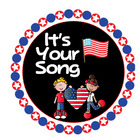
Elementary Rubric for Presentations

EDITABLE Oral Communication Rubric

Show and Tell Speaking Rubric (Memento)

Peer Evaluation Form: Presenting

Lead With Lit: Complete SEL and Community Building Mini-Lesson

Paper Bag Book Report

Grade 1-3 Oral Communication - Single Point Rubric (Ontario Curriculum)

Show You Know: A Check for Understanding

Speaking and Listening Checklist for Upper Grade Discussions

- Word Document File
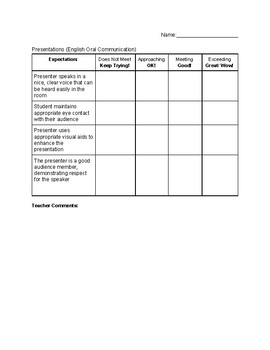
Book Report/Celebration Rubric

Poetry Party Bundle

Grab & Go Artic-Quick Speech Directions & Forms

Discussion Self - Evaluation Rubric/Checklist

SOLE (Self-Organized Learning Environment) presentation rubric
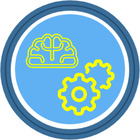
Fluency Rubric K-5

Show and Tell Activity Distance Learning and Print and Go for Speech Therapy

Oral Communication Descriptive Toy Presentation

PowerPoint Presentation Score Sheet

Participation Tracker (Rubric)

Rubrica de colaboracion grupal (Spanish)

- We're hiring
- Help & FAQ
- Privacy policy
- Student privacy
- Terms of service
- Tell us what you think
- SUGGESTED TOPICS
- The Magazine
- Newsletters
- Managing Yourself
- Managing Teams
- Work-life Balance
- The Big Idea
- Data & Visuals
- Reading Lists
- Case Selections
- HBR Learning
- Topic Feeds
- Account Settings
- Email Preferences
What It Takes to Give a Great Presentation
- Carmine Gallo

Five tips to set yourself apart.
Never underestimate the power of great communication. It can help you land the job of your dreams, attract investors to back your idea, or elevate your stature within your organization. But while there are plenty of good speakers in the world, you can set yourself apart out by being the person who can deliver something great over and over. Here are a few tips for business professionals who want to move from being good speakers to great ones: be concise (the fewer words, the better); never use bullet points (photos and images paired together are more memorable); don’t underestimate the power of your voice (raise and lower it for emphasis); give your audience something extra (unexpected moments will grab their attention); rehearse (the best speakers are the best because they practice — a lot).
I was sitting across the table from a Silicon Valley CEO who had pioneered a technology that touches many of our lives — the flash memory that stores data on smartphones, digital cameras, and computers. He was a frequent guest on CNBC and had been delivering business presentations for at least 20 years before we met. And yet, the CEO wanted to sharpen his public speaking skills.
- Carmine Gallo is a Harvard University instructor, keynote speaker, and author of 10 books translated into 40 languages. Gallo is the author of The Bezos Blueprint: Communication Secrets of the World’s Greatest Salesman (St. Martin’s Press).
Partner Center
Oral Presentation Rubric

About this printout
This rubric is designed to be used for any oral presentation. Students are scored in three categories—delivery, content, and audience awareness.
Teaching with this printout
More ideas to try, related resources.
Oral presentation and speaking are important skills for students to master, especially in the intermediate grades. This oral presentation rubric is designed to fit any topic or subject area. The rubric allows teachers to assess students in several key areas of oral presentation. Students are scored on a scale of 1–4 in three major areas. The first area is Delivery, which includes eye contact, and voice inflection. The second area, Content/Organization, scores students based on their knowledge and understanding of the topic being presented and the overall organization of their presentation. The third area, Enthusiasm/Audience Awareness, assesses students based on their enthusiasm toward the topic and how well they came across to their intended audience. Give students the oral presentation rubric ahead of time so that they know and understand what they will be scored on. Discuss each of the major areas and how they relate to oral presentation.
- After students have completed their oral presentations, ask them to do a self-assessment with the same rubric and hold a conference with them to compare their self-assessment with your own assessment.
- Provide students with several examples of oral presentations before they plan and execute their own presentation. Ask students to evaluate and assess the exemplar presentations using the same rubric.
- Students can do a peer evaluation of oral presentations using this rubric. Students meet in partners or small groups to give each other feedback and explain their scoring.
- Lesson Plans
- Student Interactives
Students research engineering careers and create poetry to understand the vocabulary of STEM (science, technology, engineering, and mathematics).
Useful for a wide variety of reading and writing activities, this outlining tool allows students to organize up to five levels of information.
- Print this resource
Explore Resources by Grade
- Kindergarten K
Ideas and insights from Harvard Business Publishing Corporate Learning

Powerful and Effective Presentation Skills: More in Demand Now Than Ever

When we talk with our L&D colleagues from around the globe, we often hear that presentation skills training is one of the top opportunities they’re looking to provide their learners. And this holds true whether their learners are individual contributors, people managers, or senior leaders. This is not surprising.
Effective communications skills are a powerful career activator, and most of us are called upon to communicate in some type of formal presentation mode at some point along the way.
For instance, you might be asked to brief management on market research results, walk your team through a new process, lay out the new budget, or explain a new product to a client or prospect. Or you may want to build support for a new idea, bring a new employee into the fold, or even just present your achievements to your manager during your performance review.
And now, with so many employees working from home or in hybrid mode, and business travel in decline, there’s a growing need to find new ways to make effective presentations when the audience may be fully virtual or a combination of in person and remote attendees.
Whether you’re making a standup presentation to a large live audience, or a sit-down one-on-one, whether you’re delivering your presentation face to face or virtually, solid presentation skills matter.
Even the most seasoned and accomplished presenters may need to fine-tune or update their skills. Expectations have changed over the last decade or so. Yesterday’s PowerPoint which primarily relied on bulleted points, broken up by the occasional clip-art image, won’t cut it with today’s audience.
The digital revolution has revolutionized the way people want to receive information. People expect presentations that are more visually interesting. They expect to see data, metrics that support assertions. And now, with so many previously in-person meetings occurring virtually, there’s an entirely new level of technical preparedness required.
The leadership development tools and the individual learning opportunities you’re providing should include presentation skills training that covers both the evergreen fundamentals and the up-to-date capabilities that can make or break a presentation.
So, just what should be included in solid presentation skills training? Here’s what I think.
The fundamentals will always apply When it comes to making a powerful and effective presentation, the fundamentals will always apply. You need to understand your objective. Is it strictly to convey information, so that your audience’s knowledge is increased? Is it to persuade your audience to take some action? Is it to convince people to support your idea? Once you understand what your objective is, you need to define your central message. There may be a lot of things you want to share with your audience during your presentation, but find – and stick with – the core, the most important point you want them to walk away with. And make sure that your message is clear and compelling.
You also need to tailor your presentation to your audience. Who are they and what might they be expecting? Say you’re giving a product pitch to a client. A technical team may be interested in a lot of nitty-gritty product detail. The business side will no doubt be more interested in what returns they can expect on their investment.
Another consideration is the setting: is this a formal presentation to a large audience with questions reserved for the end, or a presentation in a smaller setting where there’s the possibility for conversation throughout? Is your presentation virtual or in-person? To be delivered individually or as a group? What time of the day will you be speaking? Will there be others speaking before you and might that impact how your message will be received?
Once these fundamentals are established, you’re in building mode. What are the specific points you want to share that will help you best meet your objective and get across your core message? Now figure out how to convey those points in the clearest, most straightforward, and succinct way. This doesn’t mean that your presentation has to be a series of clipped bullet points. No one wants to sit through a presentation in which the presenter reads through what’s on the slide. You can get your points across using stories, fact, diagrams, videos, props, and other types of media.
Visual design matters While you don’t want to clutter up your presentation with too many visual elements that don’t serve your objective and can be distracting, using a variety of visual formats to convey your core message will make your presentation more memorable than slides filled with text. A couple of tips: avoid images that are cliched and overdone. Be careful not to mix up too many different types of images. If you’re using photos, stick with photos. If you’re using drawn images, keep the style consistent. When data are presented, stay consistent with colors and fonts from one type of chart to the next. Keep things clear and simple, using data to support key points without overwhelming your audience with too much information. And don’t assume that your audience is composed of statisticians (unless, of course, it is).
When presenting qualitative data, brief videos provide a way to engage your audience and create emotional connection and impact. Word clouds are another way to get qualitative data across.
Practice makes perfect You’ve pulled together a perfect presentation. But it likely won’t be perfect unless it’s well delivered. So don’t forget to practice your presentation ahead of time. Pro tip: record yourself as you practice out loud. This will force you to think through what you’re going to say for each element of your presentation. And watching your recording will help you identify your mistakes—such as fidgeting, using too many fillers (such as “umm,” or “like”), or speaking too fast.
A key element of your preparation should involve anticipating any technical difficulties. If you’ve embedded videos, make sure they work. If you’re presenting virtually, make sure that the lighting is good, and that your speaker and camera are working. Whether presenting in person or virtually, get there early enough to work out any technical glitches before your presentation is scheduled to begin. Few things are a bigger audience turn-off than sitting there watching the presenter struggle with the delivery mechanisms!
Finally, be kind to yourself. Despite thorough preparation and practice, sometimes, things go wrong, and you need to recover in the moment, adapt, and carry on. It’s unlikely that you’ll have caused any lasting damage and the important thing is to learn from your experience, so your next presentation is stronger.
How are you providing presentation skills training for your learners?
Manika Gandhi is Senior Learning Design Manager at Harvard Business Publishing Corporate Learning. Email her at [email protected] .
Let’s talk
Change isn’t easy, but we can help. Together we’ll create informed and inspired leaders ready to shape the future of your business.
© 2024 Harvard Business School Publishing. All rights reserved. Harvard Business Publishing is an affiliate of Harvard Business School.
- Privacy Policy
- Copyright Information
- Terms of Use
- About Harvard Business Publishing
- Higher Education
- Harvard Business Review
- Harvard Business School
We use cookies to understand how you use our site and to improve your experience. By continuing to use our site, you accept our use of cookies and revised Privacy Policy .
Cookie and Privacy Settings
We may request cookies to be set on your device. We use cookies to let us know when you visit our websites, how you interact with us, to enrich your user experience, and to customize your relationship with our website.
Click on the different category headings to find out more. You can also change some of your preferences. Note that blocking some types of cookies may impact your experience on our websites and the services we are able to offer.
These cookies are strictly necessary to provide you with services available through our website and to use some of its features.
Because these cookies are strictly necessary to deliver the website, refusing them will have impact how our site functions. You always can block or delete cookies by changing your browser settings and force blocking all cookies on this website. But this will always prompt you to accept/refuse cookies when revisiting our site.
We fully respect if you want to refuse cookies but to avoid asking you again and again kindly allow us to store a cookie for that. You are free to opt out any time or opt in for other cookies to get a better experience. If you refuse cookies we will remove all set cookies in our domain.
We provide you with a list of stored cookies on your computer in our domain so you can check what we stored. Due to security reasons we are not able to show or modify cookies from other domains. You can check these in your browser security settings.
We also use different external services like Google Webfonts, Google Maps, and external Video providers. Since these providers may collect personal data like your IP address we allow you to block them here. Please be aware that this might heavily reduce the functionality and appearance of our site. Changes will take effect once you reload the page.
Google Webfont Settings:
Google Map Settings:
Google reCaptcha Settings:
Vimeo and Youtube video embeds:
You can read about our cookies and privacy settings in detail on our Privacy Policy Page.
Home Blog Education Presentation Skills 101: A Guide to Presentation Success
Presentation Skills 101: A Guide to Presentation Success
Getting the perfect presentation design is just a step toward a successful presentation. For the experienced user, building presentation skills is the answer to elevating the power of your message and showing expertise on any subject. Still, one can ask: is it the same set of skills, or are they dependable on the type of presentation?
In this article, we will introduce the different types of presentations accompanied by the skillset required to master them. The purpose, as always, is to retain the audience’s interest for a long-lasting and convincing message.

Table of Contents
The Importance of Presentation Skills
Persuasive presentations, instructional presentations, informative presentations, inspirational presentations, basic presentation skills, what are the main difficulties when giving a presentation, recommendations to improve your presentation skills, closing statement.
Effective communication is the answer to reaching business and academic goals. The scenarios in which we can be required to deliver a presentation are as diverse as one can imagine. Still, some core concepts apply to all presentations.
We define presentation skills as a compendium of soft skills that directly affect your presentation performance and contribute to creating a great presentation. These are not qualities acquired by birth but skills you ought to train and master to delve into professional environments.
You may ask: is it really that evident when a presenter is not prepared? Here are some common signs people can experience during presentations:
- Evasive body language: Not making eye contact with the audience, arms closed tightly to the body, hands in pockets all the time.
- Lack of interest in the presenter’s voice: dull tone, not putting an effort to articulate the topics.
- Doubting when asked to answer a question
- Irksome mood
The list can go on about common presenter mistakes , and most certainly, it will affect the performance of any presented data if the lack of interest by the presenter is blatantly obvious. Another element to consider is anxiety, and according to research by the National Institute of Mental Health, 73% of the population in the USA is affected by glossophobia , which is the fear of public speaking, judgment, or negative evaluation by other people.
Therefore, presentation skills training is essential for any business professional who wants to achieve effective communication . It will remove the anxiety from presentation performance and help users effectively deliver their message and connect with the audience.
Archetypes of presentations
Persuasive presentations aim to convince the audience – often in short periods – to acquire a product or service, adhere to a cause, or invest in a company. For business entrepreneurs or politicians, persuasive presentations are their tool for the trade.
Unless you aim to be perceived as an imposter, a proper persuasive presentation has the elements of facts, empathy, and logic, balanced under a well-crafted narrative. The central pillar of these presentations is to identify the single factor that gathered your audience: it could be a market need, a social cause, or a revolutionary concept for today’s society. It has to be something with enough power to gather critiques – both good and bad.
That single factor has to be backed up by facts. Research that builds your hypothesis on how to solve that problem. A deep understanding of the target audience’s needs , concerns, and social position regarding the solution your means can offer. When those elements are in place, building a pitch becomes an easy task.
Graphics can help you introduce information in a compelling format, lowering the need for lengthy presentations. Good presentation skills for persuasive presentations go by the hand of filtering relevant data and creating the visual cues that resonate with what your audience demands.
One powerful example of a persuasive presentation is the technique known as the elevator pitch . You must introduce your idea or product convincingly to the audience in a timeframe between 30 seconds and less than 2 minutes. You have to expose:
- What do you do
- What’s the problem to solve
- Why is your solution different from others
- Why should the audience care about your expertise

For that very purpose, using engaging graphics with contrasting colors elevates the potential power of your message. It speaks professionalism, care for details, and out-of-the-box thinking. Knowing how to end a presentation is also critical, as your CTAs should be placed with care.
Therefore, let’s resume the requirements of persuasive presentations in terms of good presentation skills:
- Identifying problems and needs
- Elaborating “the hook” (the element that grabs the audience’s attention)
- Knowing how to “tie” your audience (introducing a piece of information related to the hook that causes an emotional impact)
- Broad knowledge of body language and hand gestures to quickly convey your message
- Being prepared to argue a defense of your point of view
- Handling rejection
- Having a proactive attitude to convert opportunities into new projects
- Using humor, surprise, or personal anecdotes as elements to sympathize with the audience
- Having confidence
- Be able to summarize facts and information in visually appealing ways

You can learn more about persuasive presentation techniques by clicking here .
In the case of instructional presentations, we ought to differentiate two distinctive types:
- Lecture Presentations : Presentations being held at universities or any other educative institution. Those presentations cover, topic by topic, and the contents of a syllabus and are created by the team of teachers in charge of the course.
- Training Presentations : These presentations take place during in-company training sessions and usually comprise a good amount of content that is resumed into easy-to-take solutions. They are aimed to coach employees over certain topics relevant to their work performance. The 70-20-10 Model is frequently used to address these training situations.
Lecture presentations appeal to the gradual introduction of complex concepts, following a structure set in the course’s syllabus. These presentations often have a similar aesthetic as a group of professors or researchers created to share their knowledge about a topic. Personal experience does tell that course presentations often rely on factual data, adequately documented, and on the theoretical side.
An example of a presentation that lies under this concept is a Syllabus Presentation, used by the teaching team to introduce the subject to new students, evaluation methods, concepts to be learned, and expectations to pass the course.

On the other hand, training presentations are slide decks designed to meet an organization’s specific needs in the formal education of their personnel. Commonly known as “continuous education,” plenty of companies invest resources in coaching their employees to achieve higher performance results. These presentations have the trademark of being concise since their idea is to introduce the concepts that shall be applied in practice sessions.
Ideally, the training presentations are introduced with little text and easy-to-recognize visual cues. Since the idea is to summarize as much as possible, these are visually appealing for the audience. They must be dynamic enough to allow the presenter to convey the message.

Those key takeaways remind employees when they revisit their learning resources and allow them to ruminate on questions that fellow workers raise.
To sum up this point, building presentation skills for instructional presentations requires:
- Ability to put complex concepts into simpler words
- Patience and a constant learning mindset
- Voice training to deliver lengthy speeches without being too dense
- Ability to summarize points and note the key takeaways
- Empathizing with the audience to understand their challenges in the learning process

The informative presentations take place in business situations, such as when to present project reports from different departments to the management. Another potential usage of these presentations is in SCRUM or other Agile methodologies, when a sprint is completed, to discuss the advance of the project with the Product Owner.
As they are presentations heavily dependent on data insights, it’s common to see the usage of infographics and charts to express usually dense data in simpler terms and easy to remember.

Informative presentations don’t just fall into the business category. Ph.D. Dissertation and Thesis presentations are topics that belong to the informative presentations category as they condense countless research hours into manageable reports for the academic jury.

Since these informational presentations can be perceived as lengthy and data-filled, it is important to learn the following professional presentation skills:
- Attention to detail
- Be able to explain complex information in simpler terms
- Creative thinking
- Powerful diction
- Working on pauses and transitions
- Pacing the presentation, so not too much information is divulged per slide

The leading inspirational platform, TEDx, comes to mind when talking about inspirational presentations. This presentation format has the peculiarity of maximizing the engagement with the audience to divulge a message, and due to that, it has specific requirements any presenter must meet.
This presentation format usually involves a speaker on a stage, either sitting or better standing, in which the presenter engages with the audience with a storytelling format about a life experience, a job done that provided a remarkable improvement for society, etc.

Empathizing with the audience is the key ingredient for these inspirational presentations. Still, creativity is what shapes the outcome of your performance as people are constantly looking for different experiences – not the same recipe rephrased with personal touches. The human factor is what matters here, way above data and research. What has your experience to offer to others? How can it motivate another human being to pursue a similar path or discover their true calling?
To achieve success in terms of communication skills presentation, these inspirational presentations have the following requirements:
- Focus on the audience (engage, consider their interests, and make them a part of your story)
- Putting ego aside
- Creative communication skills
- Storytelling skills
- Body language knowledge to apply the correct gestures to accompany your story
- Voice training
- Using powerful words

After discussing the different kinds of presentations we can come across at any stage of our lives, a group of presentation skills is standard in any type of presentation. See below what makes a good presentation and which skills you must count on to succeed as a presenter.
Punctuality
Punctuality is a crucial aspect of giving an effective presentation. Nothing says more about respect for your audience and the organization you represent than delivering the presentation on time . Arriving last minute puts pressure on the tech team behind audiovisuals, as they don’t have enough preparation to test microphones, stage lights, and projector settings, which can lead to a less powerful presentation Even when discussing presentations hosted in small rooms for a reduced audience, testing the equipment becomes essential for an effective presentation.
A solution for this is to arrive at least 30 minutes early. Ideally, one hour is a sweet spot since the AV crew has time to check the gear and requirements for your presentation. Another benefit of this, for example, in inspirational presentations, is measuring the previous presenter’s impact on the audience. This gives insights about how to resonate with the public, and their interest, and how to accommodate your presentation for maximum impact.
Body Language
Our bodies can make emotions transparent for others, even when we are unaware of such a fact. Proper training for body language skills reduces performance anxiety, giving the audience a sense of expertise about the presented topic.
Give your presentation and the audience the respect they deserve by watching over these potential mistakes:
- Turning your back to the audience for extended periods : It’s okay to do so when introducing an important piece of information or explaining a graph, but it is considered rude to give your back to the audience constantly.
- Fidgeting : We are all nervous in the presence of strangers, even more, if we are the center of attention for that moment. Instead of playing with your hair or making weird hand gestures, take a deep breath to center yourself before the presentation and remember that everything you could do to prepare is already done. Trust your instincts and give your best.
- Intense eye contact : Have you watched a video where the presenter stared at the camera the entire time? That’s the feeling you transmit to spectators through intense eye contact. It’s a practice often used by politicians to persuade.
- Swearing : This is a no-brainer. Even when you see influencers swearing on camera or in podcasts or live presentations, it is considered an informal and lousy practice for business and academic situations. If you have a habit to break when it comes to this point, find the humor in these situations and replace your swear words with funny alternatives (if the presentation allows for it).
Voice Tone plays a crucial role in delivering effective presentations and knowing how to give a good presentation. Your voice is a powerful tool for exposing your ideas and feelings . Your voice can articulate the message you are telling, briefing the audience if you feel excited about what you are sharing or, in contrast, if you feel the presentation is a burden you ought to complete.
Remember, passion is a primary ingredient in convincing people. Therefore, transmitting such passion with a vibrant voice may help gather potential business partners’ interest.
But what if you feel sick prior to the presentation? If, by chance, your throat is sore minutes before setting foot on the stage, try this: when introducing yourself, mention that you are feeling a bit under the weather. This resonates with the audience to pay more attention to your efforts. In case you don’t feel comfortable about that, ask the organizers for a cup of tea, as it will settle your throat and relax your nerves.
Tech Skills
Believe it or not, people still feel challenged by technology these days. Maybe that’s the reason why presentation giants like Tony Robbins opt not to use PowerPoint presentations . The reality is that there are plenty of elements involved in a presentation that can go wrong from the tech side:
- A PDF not opening
- Saving your presentation in a too-recent PowerPoint version
- A computer not booting up
- Mac laptops and their never-ending compatibility nightmare
- Not knowing how to change between slides
- Not knowing how to use a laser pointer
- Internet not working
- Audio not working
We can come up with a pretty long list of potential tech pitfalls, and yet more than half of them fall in presenters not being knowledgeable about technology.
If computers aren’t your thing, let the organization know about this beforehand. There is always a crew member available to help presenters switch between slides or configure the presentation for streaming. This takes the pressure off your shoulders, allowing you to concentrate on the content to present. Remember, even Bill Gates can get a BSOD during a presentation .
Presentations, while valuable for conveying information and ideas, can be daunting for many individuals. Here are some common difficulties people encounter when giving presentations:
Public Speaking Anxiety
Glossophobia, the fear of public speaking, affects a significant portion of the population. This anxiety can lead to nervousness, trembling, and forgetfulness during a presentation.
Lack of Confidence
Many presenters struggle with self-doubt, fearing that they may not be knowledgeable or skilled enough to engage their audience effectively.
Content Organization
Organizing information in a coherent and engaging manner can be challenging. Presenters often grapple with how to structure their content to make it easily digestible for the audience. Artificial Intelligence can help us significantly reduce the content arrangement time when you work with tools like our AI Presentation Maker (made for presenters by experts in presentation design).
Audience Engagement
Keeping the audience’s attention and interest throughout the presentation can be difficult. Distractions, disengaged attendees, or lack of interaction can pose challenges.
Technical Issues
Technology glitches, such as malfunctioning equipment, incompatible file formats, or poor internet connectivity, can disrupt presentations and increase stress.
Time Management
Striking the right balance between providing enough information and staying within time limits is a common challenge. Going over or under the allotted time can affect the effectiveness of the presentation.
Handling Questions and Challenges
Responding to unexpected questions, criticism, or challenges from the audience can be difficult, especially when presenters are unprepared or lack confidence in their subject matter.
Visual Aids and Technology
Creating and effectively using visual aids like slides or multimedia can be a struggle for some presenters. Technical competence is essential in this aspect.
Language and Articulation
Poor language skills or unclear articulation can hinder effective communication. Presenters may worry about stumbling over words or failing to convey their message clearly.
Maintaining appropriate and confident body language can be challenging. Avoiding nervous habits, maintaining eye contact, and using gestures effectively requires practice.
Overcoming Impersonal Delivery
In virtual presentations, maintaining a personal connection with the audience can be difficult. The absence of face-to-face interaction can make it challenging to engage and read the audience.
Cultural and Diversity Awareness
Presenting to diverse audiences requires sensitivity to cultural differences and varying levels of familiarity with the topic.
In this section, we gathered some tips on how to improve presentation skills that can certainly make an impact if applied to your presentation skills. We believe these skills can be cultivated to transform into habits for your work routine.
Tip #1: Build a narrative
One memorable way to guarantee presentation success is by writing a story of all the points you desire to cover. This statement is based on the logic behind storytelling and its power to connect with people .
Don’t waste time memorizing slides or reading your presentation to the audience. It feels unnatural, and any question that diverts from the topic in discussion certainly puts you in jeopardy or, worse, exposes you as a fraud in the eyes of the audience. And before you ask, it is really evident when a presenter has a memorized speech.
Build and rehearse the presentation as if telling a story to a group of interested people. Lower the language barrier by avoiding complex terms that maybe even you aren’t fully aware of their meaning. Consider the ramifications of that story, what it could lead to, and which are the opportunities to explore. Then, visualize yourself giving the presentation in a natural way.
Applying this technique makes the presentation feel like second nature to you. It broadens the spectrum in which you can show expertise over a topic or even build the basis for new interesting points of view about the project.
Tip #2: Don’t talk for more than 3 minutes per slide
It is a common practice of presenters to bombard the audience with facts and information whilst retaining the same slide on the screen. Why can this happen? It could be because the presenter condensed the talk into very few slides and preferred to talk. The reality is that your spectators won’t retain the information you are giving unless you give visual cues to help that process.
Opt to prepare more slides and pace your speech to match the topics shown on each slide. Don’t spend more than 3 minutes per slide unless you have to introduce a complex piece of data. Use visual cues to direct the spectators about what you talk about, and summarize the principal concepts discussed at the end of each section.
Tip #3: Practice meditation daily
Anxiety is the number one enemy of professional presenters. It slowly builds without you being aware of your doubts and can hinder your performance in multiple ways: making you feel paralyzed, fidgeting, making you forget language skills or concepts, affecting your health, etc.
Meditation is an ancient practice taken from Buddhist teachings that train your mind to be here in the present. We often see the concepts of meditation and mindfulness as synonyms, whereas you should be aware that meditation is a practice that sets the blocks to reach a state of mindfulness. For presenters, being in the here and now is essential to retain focus, but meditation techniques also teach us to control our breathing and be in touch with our body signals when stress builds up.
The customary practice of meditation has an impact on imagination and creativity but also helps to build patience – a skill much needed for connecting with your audience in instructional presentations.
Having the proper set of presentation skills can be quite subjective. It goes beyond presentation tips and deepens into how flexible we can be in our ability to communicate ideas.
Different presentations and different audiences shape the outcome of our efforts. Therefore, having a basic understanding of how to connect, raise awareness, and empathize with people can be key ingredients for your career as a presenter. A word of advice: success doesn’t happen overnight. It takes dedication and patience to build communication skills . Don’t condition your work to believe you will be ready “someday”; it’s best to practice and experience failure as part of the learning process.

Like this article? Please share
Business Presentations, Presentation Approaches, Presentation Skills Filed under Education
Related Articles

Filed under Business • April 22nd, 2024
Setting SMART Goals – A Complete Guide (with Examples + Free Templates)
This guide on SMART goals introduces the concept, explains the definition and its meaning, along the main benefits of using the criteria for a business.

Filed under Design • March 27th, 2024
How to Make a Presentation Graph
Detailed step-by-step instructions to master the art of how to make a presentation graph in PowerPoint and Google Slides. Check it out!

Filed under Presentation Ideas • February 29th, 2024
How to Make a Fundraising Presentation (with Thermometer Templates & Slides)
Meet a new framework to design fundraising presentations by harnessing the power of fundraising thermometer templates. Detailed guide with examples.
Leave a Reply
Presentation Skills 3: The Rule of Three

This is one of the oldest of all the presentation techniques – known about since the time of Aristotle.
People tend to remember lists of three things. Structure your presentation around threes and it will become more memorable.
The Rule of Three – We remember three things.
The rule of three is one of the oldest in the book – Aristotle wrote about it in his book Rhetoric. Put simply it is that people tend to easily remember three things.
Remember as a kid when your mum sent you down to the shop to buy a number of things. But when you got to the shop all you could remember were three things. This is the rule of three
Odds are that people will only remember three things from your presentation
What will they be?
1. The audience are likely to remember only three things from your presentation – plan in advance what these will be.
Believe it or not, the chances are, people will only remember three things from your presentation. So before you start writing your presentation, plan what your three key messages will be. Once you have these messages, structure the main part of your presentation around these three key themes and look at how they could be better illustrated.
2. There are three parts to your presentation
The beginning, the middle and the end. Start to plan out what you will do in these three parts. The beginning is ideal for an attention grabber or for an ice breaker. The end is great to wrap things up or to end with a grand finale.
3. Use lists of three wherever you can in your presentation
Lists of three have been used from early times up to the present day. They are particularly used by politicians and advertisers who know the value of using the rule of three to sell their ideas.
Veni, Vidi, Vici (I came, I saw, I conquered) – Julius Caesar** “ Friends, Romans, Countrymen lend me your ears” – William Shakespeare “Our priorities are Education, Education, Education ” – Tony Blair A Mars a day helps you to work, rest and play – Advertising slogan Stop, look and listen – Public safety announcement
A classic example of the rule of three was Winston Churchill’s famous Blood, Sweat and Tears speech. He is widely attributed as saying I can promise you nothing but blood sweat and tears. What he actually said was “I can promise you Blood, Sweat, Toil and Tears”. Because of the rule of three we simply remember it as Blood sweat and tears.
There are lots of other examples of the rule of three on this link
4. In Presentations “Less is More”
If you have four points to get across – cut one out. They won’t remember it anyway. In presentations less really is more. No one ever complained of a presentation being too short.
Presentation Essentials
Three Presentation Essentials
- Use visual aids where you can
- Rehearse, rehearse, rehearse
- The audience will only remember three messages
So there you have the presentation essentials. I suggest that you print out this little box and stick it in your work book for future reference.
** Technically the quote is – Veni (I came), Vidi (I saw), Vici (I crushed them) which is falsely tied to Gaul and Britanny Conquest by Julius Caesar, but was pronounced before the Senate after the crushing of a small revolt in what is now Turkey…
Recommended Pages

I get the point but find it slightly humorous and ironic that you give four reasons as to why people remember things in three. Why not take your own advice and keep the list to three?
great.usefull.simple
Interesting, useful
highly informative with excellent examples
Why do people tend to remember three things?
- All Templates
- Persuasive Speech Topics
- Informative
- Architecture
- Celebration
- Educational
- Engineering
- Food and Drink
- Subtle Waves Template
- Business world map
- Filmstrip with Countdown
- Blue Bubbles
- Corporate 2
- Vector flowers template
- Editable PowerPoint newspapers
- Hands Template
- Red blood cells slide
- Circles Template on white
- Maps of America
- Light Streaks Business Template
- Zen stones template
- Heartbeat Template
- Web icons template

IMAGES
VIDEO
COMMENTS
The three basic parts. • Introduction—This is your chance to engage your audience and really capture their interest in the subject you are presenting. Use a funny personal experience or a dramatic story, or start with an intriguing question. • Body—This is the longest part of your report. Here you elaborate on the facts and ideas you ...
You will see a decided improvement in your child's eye contact, body language, and presentation skills. Free Assessment! Take this quiz and get a report on your child's milestones and a personalized learning plan. Start the Assessment. ... I have a toddler (3-years-old) and we started around the age of 2 to show her the basics of hygiene ...
Presentation Tip: Kids can ask a question, conduct a quick poll, or invite responses to a statement. This not only keeps the audience engaged but also makes the presentation more interactive and enjoyable for the presenter. 11. Stay Calm and Composed. Keeping calm under the spotlight is key.
Presentation skills are the abilities and qualities necessary for creating and delivering a compelling presentation that effectively communicates information and ideas. They encompass what you say, how you structure it, and the materials you include to support what you say, such as slides, videos, or images. You'll make presentations at various ...
Grade: 3 - 12. Speaking in front of a crowd is always challenging, but the video provides some tips and suggestions to help make it easier. 1:35. Be a More Confident Public Speaker. Grade: 3 - 12. Learn about the Triple P method that will keep you calm and confident during your next presentation. 4:40.
Teachers will learn strategies for teaching Grade 3 speaking and listening skills, investigating standards for presentation of knowledge and ideas as well as comprehension and collaboration. Students engage in oral presentations and student-led discussion of materials read. Students will develop proficiency with Socratic Seminar and other techniques.
Presenting or making a speech at a conference or event. Objecting to a planning proposal at a council meeting. Making a speech at a wedding. Proposing a vote of thanks to someone at a club or society. On behalf of a team, saying goodbye and presenting a gift to a colleague who is leaving.
To give a great presentation, you might even incorporate relevant props or presentation slides. 4. Storytelling. According to Forbes, audiences typically pay attention for about 10 minutes before tuning out. But you can lengthen their attention span by offering a presentation that interests them for longer.
Grade 3. English Language Arts Standards Reading: Literature Reading: Informational Text ... Oral Presentation Assessment Rubric A rubric designed to help teachers to assess students' oral presentations. ... Word Grade s 3 - 6 Plus Plan Speaking Skills for Oral Presentations Poster A poster that explains the skills students need for a great ...
Teach Starter Australia. Teach Starter United States. Teach Starter United Kingdom. Help Desk. Contact Us. Suggest A Resource. Build your students listening and speaking skills this year with the help of dramatic play activities, interactive listening challenges and more...
Use this elementary level rubric to support, instruct, and assess your students as they prepare and make a presentation. This can be used for various subjects and is easy to read and understand. Subjects: English Language Arts, For All Subject Areas, Oral Communication. Grades: 3 rd - 5 th.
Here are a few tips for business professionals who want to move from being good speakers to great ones: be concise (the fewer words, the better); never use bullet points (photos and images paired ...
Graphic Organizer Prompt 1: Create a poster, chart, or some other type of graphic organizer that lists the importance of good presentation skills for both the audience and the presenter. Example ...
Oral presentation and speaking are important skills for students to master, especially in the intermediate grades. This oral presentation rubric is designed to fit any topic or subject area. The rubric allows teachers to assess students in several key areas of oral presentation. Students are scored on a scale of 1-4 in three major areas.
3. Presentation Skills at an Interview. Lastly, the interview. The job interview is a make-or-break performance for you, and presentation skills will be needed in spades. While most of our presentation preparation tips from before are relevant, here is a quick way to ace your interview:
First things first, let's talk about some presentation no-nos. You want to avoid these mistakes in any presentation you give—from a presentation for a grade in your middle school class all the way up to a business presentation. Key presentation don'ts are: Don't create slides full of text—your presentation is not a 30-page essay ...
This is not surprising. Effective communications skills are a powerful career activator, and most of us are called upon to communicate in some type of formal presentation mode at some point along the way. For instance, you might be asked to brief management on market research results, walk your team through a new process, lay out the new budget ...
This brilliant Unit pack includes all the lesson packs and additional and home learning resources included in the PlanIt Year 3 Computing unit 'PowerPoint Presentation Skills'. For more resources like this, you might want to try another Lesson Plan for Teaching PowerPoint.
Tip #1: Build a narrative. One memorable way to guarantee presentation success is by writing a story of all the points you desire to cover. This statement is based on the logic behind storytelling and its power to connect with people. Don't waste time memorizing slides or reading your presentation to the audience.
There are three parts to your presentation. The beginning, the middle and the end. Start to plan out what you will do in these three parts. The beginning is ideal for an attention grabber or for an ice breaker. The end is great to wrap things up or to end with a grand finale. 3.
10. Smile. Smiling increases endorphins, replacing anxiety with calm and making you feel good about your presentation. Smiling also exhibits confidence and enthusiasm to the crowd. And this tip works even if you're doing a webinar and people can't see you. Just don't overdo it - no one enjoys the maniacal clown look.
Oral Presentation assessment rubric for Year Three students. Skill categories are based on Australian Curriculum English outcomes. Sign in. lizeerasmus - Verified member since 2015. Reviewed on 01 June 2017. Helpful.
Oral Presentation Grading Rubric Name: _____ Overall Score: /40 Nonverbal Skills 4 - Exceptional 3 - Admirable 2 - Acceptable 1 - Poor Eye Contact Holds attention of entire audience with the use of direct eye contact, seldom looking at notes or slides. Consistent use of direct eye
Glaze graded well in 2023, posting an 83.6 pass-blocking grade, but his movement skills are a bit lacking for an NFL tackle, making him a better option on the interior. Richardson — Richardson is a plus player against the run and earned a career-best 75.9 PFF run-defense grade in 2023. He missed just 3.9% of his tackle attempts last season.
Day 3 grade: A. Analysis: The Cardinals did a nice job over the first two days of the draft. ... Analysis: Morgan's pass-protection skills give him a chance to replace three-time Pro Bowler ...